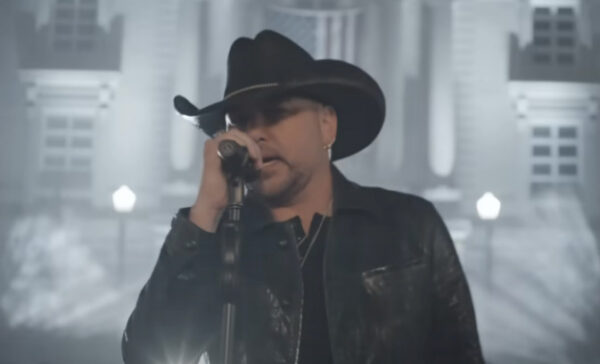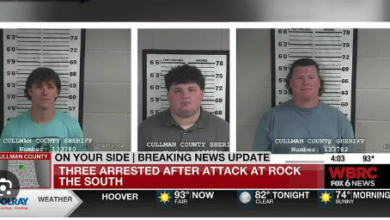Luke Bryan Pulls Video From CMT

Country music sensation Luke Bryan has made a bold move by pulling his latest music video, “Luke Bryan Pulls Video From CMT” after it sparked an intense wave of criticism and controversy. The decision comes as fans, critics, and fellow musicians weigh in on the video’s provocative content and its implications on freedom of expression in the music industry. In this in-depth article, we delve into the reasons behind Bryan’s choice, explore the reactions to the video’s themes, and examine the broader impact on artistic freedom and social responsibility. Following dogoloicohaiminh.com.vn !

I. Luke Bryan’s Decision to Pull the Video
1. The genesis of “Try That In A Small Town” music video
The inception of “Try That In A Small Town” music video began as Luke Bryan collaborated with a team of creative professionals to bring his latest song to life visually. The track itself had already garnered attention for its powerful lyrics and themes of community and standing up for one’s beliefs. Eager to complement the song’s message, Bryan aimed to create a music video that would resonate with audiences while showcasing the values he holds dear.
For privacy reasons, you can view :
- https://bom.so/umS8us
The production process involved brainstorming ideas that would represent the song’s essence authentically. A small-town setting was chosen to align with the song’s narrative of unity and resilience within a community. The scenes were carefully curated to reflect the challenges faced in contemporary society, such as civil unrest, protests, and other social issues. The team sought to highlight the importance of finding common ground and promoting empathy amidst differences.
2. Luke Bryan’s initial intentions behind the song and video
For Luke Bryan, “Try That In A Small Town” was not merely another addition to his discography; it held personal significance. The song served as a tribute to his upbringing in a close-knit community where neighbors supported each other through thick and thin. Bryan aimed to capture the essence of small-town life and portray it as a reflection of the values that should transcend political, racial, and societal differences.
The music video was intended to be a thought-provoking piece that would encourage meaningful conversations about finding common ground in times of discord. Bryan’s hope was that the video’s imagery and the song’s evocative lyrics would resonate with viewers and inspire them to embrace unity, empathy, and understanding.
3. Bryan’s response to the mounting backlash and public outcry
Following the release of the “Try That In A Small Town” music video, Luke Bryan found himself at the center of an unexpected storm of controversy. The video’s scenes depicting violence, civil unrest, and social issues provoked heated debates on social media platforms, with critics arguing that the content was inappropriate and could be interpreted as promoting gun violence and racism.
As the public outcry grew, Bryan faced a challenging decision. In a heartfelt and candid statement, he acknowledged the concerns raised by viewers and emphasized that the song and video were intended to promote unity and compassion. Despite his original intentions, Bryan recognized that artistic expression can be interpreted differently by individuals, and he deeply regretted any unintended consequences of the video’s portrayal.
In response to the mounting criticism and in consideration of the potential harm the video may have caused, Luke Bryan ultimately made the difficult decision to pull “Try That In A Small Town” from CMT’s rotation. He expressed remorse for any distress caused and expressed his commitment to using his platform responsibly to promote positive messages and bridge divides.
Bryan’s decision to pull the video sparked further discussions on the fine line between artistic freedom and social responsibility in the music industry. The aftermath of the controversy prompted musicians, fans, and industry professionals to reflect on the impact of music on society and the importance of carefully navigating the complexities of artistic expression. While the video’s withdrawal left a void in the realm of country music, it also served as a reminder of the power and responsibility that artists hold in shaping public discourse.
II. Unpacking the Controversial Content
1. A close analysis of the video’s scenes and themes
The “Try That In A Small Town” music video unfolds in a series of visually striking scenes, each carefully crafted to evoke emotions and provoke thought. The video prominently features Luke Bryan singing in front of a courthouse adorned with an American flag, symbolizing the heart of a small town. However, it is the juxtaposition of this idyllic setting with intense imagery that sparked controversy.
Throughout the video, footage of a flag burning, protesters clashing with police, and instances of civil unrest are interwoven with Bryan’s performance. Furthermore, scenes of individuals robbing a convenience store and causing destruction portray a dark and chaotic side of society. These provocative visuals are juxtaposed against Bryan’s sincere and emotive delivery of the song, creating a powerful contrast that leaves viewers with conflicting emotions.
2. Critics’ concerns about the portrayal of violence and societal issues
Critics of the music video expressed strong reservations about the inclusion of scenes depicting violence and civil unrest. They argued that such imagery could be seen as glorifying or normalizing harmful behavior. Concerns were raised about the potential impact on impressionable viewers, especially given the prevalence of real-life incidents involving violence and protests.
Some critics pointed out that the video’s use of sensitive footage from historical and contemporary events, such as flag burning and protests, could be perceived as insensitive and disrespectful to those affected by such incidents. They contended that these visuals might overshadow the intended message of unity and create a harmful distraction.
3. The song’s lyrics and their potential interpretations
The lyrics of “Try That In A Small Town” add another layer of complexity to the controversy. While Bryan maintained that the song was meant to convey a sense of community and togetherness, some critics interpreted certain lines differently. Notably, the lyrics, “Got a gun that my granddad gave me / They say one day they’re gonna round up / Well, that sh*t might fly in the city, good luck” were met with concern.
Critics argued that these lines could be perceived as a reference to resisting authority or promoting vigilantism, potentially reinforcing a negative perspective on gun ownership. They contended that in a society grappling with issues of gun violence and social unrest, the inclusion of such lyrics could be misinterpreted or misused.
In the face of varying interpretations, the song’s intended message of unity and community spirit became blurred. Some felt that the provocative scenes overshadowed the song’s essence, while others defended the video as an artistic expression open to individual perspectives.
As the discussions surrounding the video continued, Luke Bryan’s intended message of unity and understanding risked being overshadowed by the controversy. The dynamic and emotive nature of music and its visual counterparts make it a powerful tool for social commentary and self-expression. However, navigating the fine line between artistic freedom and social responsibility remains an ongoing challenge, reminding artists and audiences alike of the need for thoughtful and sensitive content creation.
III. Reactions from Fans and the Music Community
1. Social media’s role in amplifying the controversy
In the age of social media, news and controversies can quickly spread like wildfire, and the “Try That In A Small Town” music video was no exception. As soon as the video was released, it ignited heated discussions across various platforms. Social media users shared their immediate reactions, with some praising the video’s artistic choices and others expressing concern over its content.
Hashtags related to the controversy trended, attracting users from diverse backgrounds and opinions. While some fans used social media to express their unwavering support for Luke Bryan and his artistic expression, others seized the opportunity to voice their grievances and call for the video’s removal.
Social media’s amplification of the controversy played a crucial role in attracting widespread attention to the issue, ultimately leading to CMT’s decision to pull the video. However, it also showcased the power of online discourse in shaping public opinion and influencing decisions in the entertainment industry.
2. Fan opinions: divided perspectives on artistic expression vs. responsibility
Among Luke Bryan’s fan base, opinions on the controversy were polarized. Some fans staunchly defended the singer, emphasizing the importance of artistic freedom and expression. They argued that music and art should not be subject to strict censorship and that artists should have the liberty to convey their messages through their chosen medium.
On the other hand, there were fans who expressed genuine concerns about the video’s impact and potential influence on viewers, especially considering the sensitive nature of the depicted themes. They believed that artists, as public figures, should be mindful of the messages they convey, particularly in times when societal tensions are high.
The debate within the fan community highlighted the broader societal conversation surrounding the balance between artistic creativity and social responsibility. It underscored the complex relationship between artists and their audiences, as fans grappled with reconciling their admiration for Luke Bryan’s work with their concerns about the potential consequences of the controversial video.
3. Fellow musicians’ support or dissent toward Bryan’s decision
In the music community, reactions to Luke Bryan’s decision to pull the video were mixed. Some fellow musicians expressed solidarity with Bryan, commending him for taking a thoughtful and responsible approach in addressing the controversy. They supported his willingness to listen to the concerns raised by the public and make a decision that he believed was in the best interest of his audience.
Conversely, other musicians questioned the decision, advocating for artistic freedom and defending Bryan’s right to express his creative vision. They argued that creative expression often involves pushing boundaries and exploring uncomfortable themes, and that as artists, they should be allowed to express themselves authentically, even if it sparks debate.
The differing viewpoints within the music community reflected the broader diversity of perspectives on artistic expression and social responsibility. While some musicians prioritized the importance of engaging in meaningful conversations and using their platform responsibly, others stood by the notion that art should not be restrained by societal norms.
In the end, Luke Bryan’s decision and the subsequent reactions from fans and the music community demonstrated the ongoing complexities artists face in navigating the fine line between artistic freedom and social impact. The episode served as a catalyst for introspection within the music industry, prompting discussions about the responsibilities and impact of artistic expression in today’s interconnected world.
IV. CMT’s Response and Its Implications
1. CMT’s stance on the video and its withdrawal from rotation
Following the mounting controversy surrounding the “Try That In A Small Town” music video, CMT found itself at the center of the storm. As a prominent music television network, CMT had to navigate the delicate balance between supporting artistic expression and addressing public concerns.
In response to the controversy and the widespread criticism of the video’s content, CMT made the decision to withdraw the video from its rotation. The network issued a statement explaining that the withdrawal was not a judgment on the artistic merit of the video but rather a response to the sensitivities expressed by the public. CMT reaffirmed its commitment to fostering an inclusive environment and ensuring that its programming aligns with its viewers’ values.
The decision to pull the video from rotation demonstrated the influence of public opinion and the significance of social responsibility in the entertainment industry. It also underscored the evolving role of media platforms in responding to sensitive content and the implications for artists whose work sparks debates.
2. The impact of the decision on Luke Bryan’s career and reputation
For Luke Bryan, the withdrawal of the music video had implications beyond its absence from CMT’s rotation. The controversy shed light on the challenges artists face when attempting to convey complex themes through their work. While some fans lauded Bryan’s integrity in addressing the situation, others expressed disappointment in the video’s removal, perceiving it as a limitation on artistic freedom.
The incident also affected Bryan’s reputation, with some critics questioning his judgment in producing a video that included sensitive imagery. However, his response to the controversy and his willingness to engage in conversations about the video’s intent demonstrated his commitment to maintaining transparency and open communication with his audience.
In the long term, the impact on Luke Bryan’s career remained uncertain. The controversy may have influenced the perception of his artistry for some, while others may continue to support him despite the incident. The ultimate ramifications would largely depend on Bryan’s future work and his ability to strike a balance between creative expression and social responsibility.
3. The debate over artistic freedom and censorship in the music industry
The controversy surrounding the “Try That In A Small Town” music video reignited the ongoing debate over artistic freedom and censorship in the music industry. It sparked discussions about the responsibilities of artists and media platforms in navigating sensitive subject matter and the potential consequences of provocative content.
Critics argued that artistic expression should not be curtailed and that artists should have the freedom to explore challenging themes, even if they evoke discomfort. They maintained that the essence of art lies in its ability to provoke thought and foster dialogue about societal issues.
On the other hand, proponents of social responsibility contended that artists, as influencers, bear a moral duty to consider the impact of their work on the broader public. They emphasized the need for sensitivity when handling sensitive topics and advocated for thoughtful storytelling that fosters empathy and understanding.
The “Try That In A Small Town” controversy became a microcosm of the larger conversation surrounding the balance between artistic expression and responsible content creation. It highlighted the complexities and responsibilities that come with being an artist in the modern age, where social media and public opinion play a significant role in shaping the narrative around creative work.
As the music industry continues to grapple with these nuanced issues, artists, platforms, and audiences alike are challenged to find common ground, fostering an environment where creativity can thrive while considering the ethical implications of artistic expression.
V. Reflections on Freedom of Expression
1. Exploring the line between art and social responsibility
The “Try That In A Small Town” controversy prompted a profound exploration of the delicate balance between artistic freedom and social responsibility. Artists have long been at the forefront of societal change, using their platforms to address pressing issues and provoke thought. However, the incident with Luke Bryan’s music video underscored the importance of considering the potential consequences of artistic expression.
While artists should have the freedom to express themselves creatively, the controversy highlighted the need for thoughtful reflection on the impact their work might have on individuals and communities. Art has the power to evoke emotions, challenge perceptions, and spark dialogue, but it should also be approached with a sense of empathy and understanding for diverse perspectives.
The incident challenged artists and audiences alike to engage in meaningful discussions about the line between artistic expression and responsible content creation. By fostering an environment that encourages open dialogue, artists can strike a balance between pushing boundaries and being mindful of the sensitivities of their audiences.
2. The enduring power of music as a catalyst for societal dialogue
Throughout history, music has proven to be a powerful catalyst for societal dialogue. It has the ability to transcend barriers and connect people from different walks of life. The “Try That In A Small Town” controversy exemplified how music can inspire conversations about important issues, such as violence, race, and social justice.
By sparking discussions and debates, music can influence public opinion and contribute to the evolution of social norms. It serves as a mirror to society, reflecting its triumphs and challenges, and empowering individuals to contemplate and engage with pressing matters.
The incident with Luke Bryan’s music video highlighted the enduring power of music to drive change and emphasized the responsibility artists carry in shaping public discourse. It demonstrated that music is not just entertainment but a potent tool for exploring complex issues and fostering understanding among diverse communities.
3. Lessons learned from the “Try That In A Small Town” controversy
The “Try That In A Small Town” controversy offered valuable lessons for artists, media platforms, and audiences alike. Firstly, it underscored the importance of clear communication and transparency from artists when addressing controversial works. Bryan’s response demonstrated the significance of engaging in open dialogues with fans and critics to provide context and insights into the creative process.
Secondly, the incident shed light on the evolving landscape of media and the influence of public opinion in shaping artistic decisions. As social media continues to play a pivotal role in amplifying controversies, artists and platforms must be attuned to the potential impact of their work and its reception by audiences.
Lastly, the controversy served as a reminder that music has the power to evoke strong emotions and that artists must consider the potential consequences of their art on individuals and communities. Balancing creative expression with social responsibility requires thoughtful reflection and consideration of diverse perspectives.
Ultimately, the “Try That In A Small Town” controversy challenged the music industry to introspect and engage in meaningful conversations about the role of art in society. By embracing these lessons and striving for empathy and understanding, artists can continue to create impactful music that fosters positive change while navigating the complexities of freedom of expression responsibly.
Luke Bryan’s decision to pull “Try That In A Small Town” from CMT has ignited a thought-provoking discussion on the role of artists in shaping public discourse through their work. As the music industry grapples with issues of artistic freedom and responsibility, society is reminded of the profound influence that music wields in reflecting and impacting our collective values. The reverberations of this controversy will undoubtedly echo far beyond Bryan’s video, challenging musicians and audiences alike to navigate the complex landscape where creativity and accountability intersect.
FAQ:
1. What prompted Luke Bryan to pull his music video from CMT?
The decision was made in response to a significant wave of criticism and controversy surrounding the video’s themes and content.
2. What were the specific themes and scenes in the “Try That In A Small Town” music video that sparked the backlash?
The video contained scenes depicting violence, protests, and destruction, which led to concerns about its portrayal of societal issues.
3. How did the music community react to Luke Bryan’s decision?
Reactions varied among fans and fellow musicians, with some supporting Bryan’s artistic freedom and others expressing dissent.
4. What broader implications does CMT’s response have on the music industry?
The decision to pull the video raises questions about the balance between artistic expression and social responsibility in music programming.
Please note that all information presented in this article has been obtained from a variety of sources, including wikipedia.org and several other newspapers. Although we have tried our best to verify all information, we cannot guarantee that everything mentioned is correct and has not been 100% verified. Therefore, we recommend caution when referencing this article or using it as a source in your own research or report.









